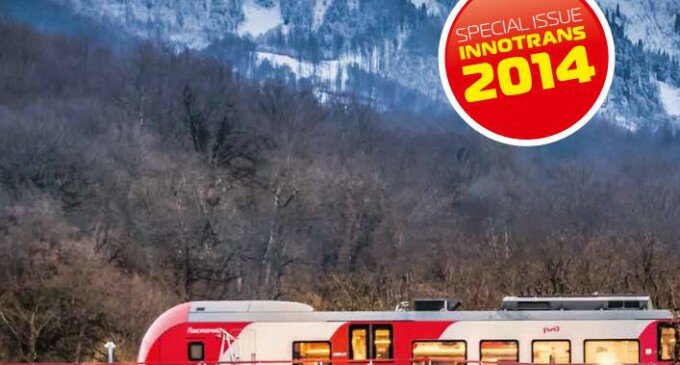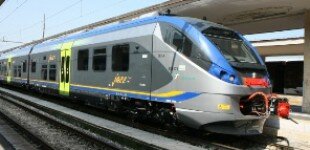Special Issue for InnoTrans 2014: Exclusive materials about Russian Railway Sector

The Institute of Natural Monopolies Research (IPEM) supported by Union of Industries of Railway Equipment (UIRE) have publish the special English-language issue of Railway Equipment magazine. The issue includes important and even exclusive materials about current Russian rail sector events, technical, economic and legal aspects of its development. The printed version of the issue will be available at InnoTrans 2014 International Trade Fair.
Contents of Special Issue 2014:
E. Yanchenko, D. Kobelkova. Developing Olympic-standard transport infrastructure facilities for Sochi
Preparations for the 2014 Sochi Winter Olympic Games began five years before the athletes arrived in the southwestern Russian city for the sporting extravaganza. The almost complete absence of the necessary infrastructure to host such a huge event was a real challenge for Russian Railways (RZD), and required intensive engineering and construction efforts in order to meet strict deadlines. New rail links and tunnels were subsequently constructed, while existing stations, terminals and transport hubs were renovated. Lastochka (Russian for Swallow) EMUs were also introduced and became one of the major attributes of the Olympic transport strategy.
A. Stepanov, I. Gurgenidze, A. Cherevan. Managing and implementing the Sochi Winter Olympics railway timetable
NIIAS utilised microsimulation to build a passenger flow to forecast passenger use of rail services during the Winter Olympic Games in Sochi. The rail timetable subsequently adopted during the Olympics is based on this model and contributed to the successful organisation of safe and efficient passenger services between the various Olympic venues.
EXPO 1520 – at the heart of Eastern Europe’s Railway Industry
The International Rail Salon EXPO 1520 held every odd year in the city of Shcherbinka, near Moscow, is the largest railway exhibition and forum in Eastern Europe and the CIS. The first event was held in 2007 and it has grown with each subsequent edition: in 2007 delegates from 12 countries attended the event, while in 2013 representatives from 25 countries, including exhibitors from Germany, Switzerland, France, China, Poland, and Slovakia took part. Indeed the 2013 show set a world record for the quantity of railway products and vehicles on display in Eastern Europe and the CIS at any one time – 127 vehicle units in total. And with substantial infrastructure and rolling stock investments expected in Russia and the CIS over the next few years, more international rolling stock and component manufacturers are expected to attend the event in the future.
N. Lysenko. UIRE develops its international reputation
Established in 2007, the mission of the Union of Industries of Railway Equipment (UIRE) non-profit partnership is to build international relationships among rail vehicle manufacturers active in Russia to exchange best manufacturing practices and technologies for rolling stock and components. UIRE’s international reputation is clearly growing. But what factors are stimulating its development?
B. Kaufmann. IRIS develops globally
In early May 2014, 8 years after its creation, IRIS awarded its 1000th certificate! This is a significant milestone for the IRIS certification which has become an international seal of quality that is increasingly recognised by rail operators and producers alike.
S. Gapeev. Business Management System: Results of Five-Year Deployment
Five years ago, Russian Railways (RZD) prioritised the adoption of International Railway Industry Standard (IRIS) at Russian rolling stock manufacturing companies. As part of its efforts to secure quality management for purchasing, RZD’s Management Board adopted several measures to ensure that rail vehicle manufacturers respect the IRIS’ international requirements during the development of new products.
M. Nigmatulin, E. Rudakov. Using IPEM indices to monitor Russian industry development in the second quarter of 2014
In 2008, in an effort to improve measurements and to offer a greater understanding of the impact of economic recessions on Russian industry, the Institute of Natural Monopolies Research (IPEM), inspired by the Russian Ministry of Industry and Trade, developed two indices to act as an alternative to the Industrial Production Index (IPI) provided by the Federal Service for National Statistics (Rosstat). IPEM-Production and IPEM-Demand are based on analyses of electrical energy consumption and railfreight volume data. These up-to-date and highly reliable indices do not have many of the drawbacks of IPI and are proven to offer significant value even during economically stable times. In addition, by comparing the dynamics of the production and demand indices, it is possible to accurately assess the probability of an economic and/or industrial downturn occurring.
A. Polikarpov, A. Slobodyanik. Russia’s railway services market reacts to significant challenges
2013 was not an easy year for Russian railway transport. Russian Railways (RZD) carried 1.237 billion tonnes of freight in 2013, a 2.8% decline on the previous year. Freight turnover also fell by 1.2% compared with 2012 amounting to 2,195.8 billion tonne-km, although freight turnover including empty running actually increased by 1.1% year-on-year to 2,812.8 billion tonne-km. The average distance of a loaded run also increased by 2% compared with 2012 to 1,574.9 km. The figures were similarly mixed for passenger traffic. RZD carried a total of 1.081 billion passengers in 2013, a 2.1% increase over 2012. However, despite suburban services reporting a 3% increase in passengers to 970.1 million, long-distance passenger traffic fell by 5% year-on-year to 110.7 million passengers, meaning that overall passenger traffic decreased by 4% compared with 2012 to 138.4 billion passenger-km.
V. Savchuk, I. Skok.The future of Russian Railway Industry
As the Russian and global economies continue to recover from the 2008 global economic crisis, Russia’s railway industry has similarly entered a phase of rehabilitation and renewal. Various measures are now underway to refurbish and renew the country’s rolling stock fleet with the latest state-of-the-art solutions, while a need to answer the increasing demands of service users, as well as the desire to develop competitive domestic products, are all spurring the growth of a revitalised domestic railway sector. However, while the measures taken have enabled some sectors and companies to return to pre-crisis output levels, many companies are struggling to match previous levels of growth.
V. Matyushin.
About new railway technical regulation system in the Custom Union
On August 2, 2014 uniform technical regulations for the operation of railway vehicles came into effect in the Custom Union member-states of Belarus, Kazakhstan, and Russia. Under the regulation system, a certificate or declaration of compliance is issued by an authorized agency, eliminating the need for additional inspections in each of the member states. The system is supported through a common register of issued and filed certificates and declarations as well as a shared technical regulation database.
O. Nazarov, D. Kiryushin, B. Khomyakov.
The Sapsan high-speed train development and acceptance tests procedures
The development of an EMU is a complex process which integrates several stages: the development of the train’s technical requirements with due regard to regulatory documents, local rolling stock and existing operations, the integration of tests including field trials, and updates to technical requirements that improve performance.
Statistics of Russian Railway Industry
The statistic material was prepared by the Institute of Natural Monopolies Research (IPEM). Source: official data of Russian state authorities, Russian Railways JSC, rolling stock manufacturers. Only in print version.
A. Nazarov. The Experience of launching Sapsan and Allegro highspeed trains in Russia
It is impossible to imagine railways in the 21st century without high-speed traffic. Russia has made good progress since it launched its inaugural high-speed project, the deployment of high-speed Sapsan trains between Saint Petersburg, Moscow and Nizhniy Novgorod in 2009 and 2010, which reduced the journey times between the cities significantly. This was subsequently followed by the introduction of the Allegro high-speed service between Saint Petersburg and Helsinki in December 2010. With high occupancy rates on these services, more and more passengers are reaping the benefits of the advanced method of travel, which boasts high-levels of service and reasonable fares.
I. Mikhalkin, O. Simakov.
The philosophy of diagnostics as a tool of intelligent control of the railway infrastructure
Russian company INFOTRANS is at the forefront of the railway infrastructure diagnostics automation process in the “Space 1520”. It’s been 25 years since the company began focusing on the development and production of diagnostic tools as well as techniques for their efficient use. The company’s specialists, who have created a large range of modern diagnostic tools for various applications, including multifunctional measuring trains, have long felt that there is a need to extend and deepen the analysis of the data they have accumulated.
N. Polukhov.
DP-M: A New-Generation Russian DMU
Metrowagonmash, a subsidiary of Transmashholding JSC, which is located in Mytishchi, near Moscow, has produced railway rolling stock products since it was founded in 1987. In 2013, the plant diversified its product range by introducing its DP-M diesel-multiple unit (DMU). Unveiled at the Fourth International Rolling Stock Exhibition, EXPO 1520, in September 2013, the new train is designed for passenger operations on non-electrified main lines with high traffic volumes.
M.Lobov.
Applying composite materials in locomotive components
Composite materials are now commonly used for interior finishes in driver’s cabs and passenger coaches of regional and long distance trains. As well as their aesthetic properties, these materials possess other characteristics that offer structural and high-tech benefits.
New Messenger Wire – as Strong as Bronze, as Conductive as Cuprum
Cuprum-based alloys with Cd, Mg, Cr, Zr and other metallic additions are used in catenary wiring because of their enhanced durability, strength and resistance to thermal softening. However, while offering various improvements to the wire's mechanical parameters, these additions inhibit the wire's electrical characteristics, significantly increase production costs, and crucially cannot be used on dense traffic lines.
A. Dorozhkin, S. Ozerov, M. Aginskih, A. Ushakov, A. Izotov.
Application of Composite Materials in Wagon Manufacturing
The Russian rail transport sector’s current high growth rate is placing greater demand on rolling stock manufacturers to offer innovative products that meet customer preferences while complying with all related infrastructure requirements and standards. Expanding the range of available rolling stock products that feature advanced technical components and offer high operating performance is a primary focus of research and production at Uralvagonzavod JSC (UVZ Group) and UKBV, which recently completed the development of an innovative freight wagon. By using the latest technologies and materials, the company hopes the product will enable them to stand out and succeed in a competitive marketplace.
M. Tarabrin.
TVEMA – Safeguarding track safety
Data from railway infrastructure diagnostic systems plays a critical role in informing the maintenance tasks which help to sustain a safe and efficient railway. In the context of increasing demands on infrastructure from very highspeed railway traffic and longer and heavier freight trains, diagnostics has never been more crucial. Diagnostics system deployed in Russia have consistently shown their reliability and regard for safety, and are set to play a key role as high-speed and freight traffic continues to grow in the next few years.
O. Kravchenko.
Innovative Hybrid Shunting Locomotive
Transmashholding JSC’s new shunting locomotive, TEM35, which is designed to diversify the company’s shunting locomotive offerings, is the first Russian-built shunter to incorporate both domestic and imported technologies, components and materials. The technologies used in the locomotive are intended to increase repair intervals, decrease the number and duration of scheduled maintenance and repair events, as well as reduce energy consumption, and harmful emissions.
D. Tikhonov.
Automatic Driving Systems for Locomotives
Preventive measures designed to improve traffic safety and reduce energy consumption from traction, including automotive processes that eliminate human error, have always warranted special attention. The inaugural intelligently control ‘automatic driving’ solution for rolling stock traction dates back to 1957, when the first trial autonomous automated deriving unit for suburban trains was conceived. However, it was not until 1998 that the first Automatic Driving System (ADS) was industrially manufactured for EMUs and introduced on vehicles operating in Moscow and maintained at Kurovskaya, Zheleznodorozhnaya and Ramenskoye depots. From 2000 onwards, automatic driving and recording systems have been gradually installed on Russian passenger and freight electric locomotives, which was followed by the deployment of the systems on main line and shunting operations in 2004.






There are no comments at the moment, do you want to add one?
Write a comment